Intervention Analysis Report: Improving Stroke Patient Discharge Care
VerifiedAdded on 2022/11/24
|9
|2341
|155
Report
AI Summary
This report presents an analysis of an organizational intervention designed to improve the discharge care plan for patients who have experienced an acute stroke. The intervention focuses on enhancing the quality of discharge care to reduce hospital stays, address unmet patient needs, and provide adequate patient education. The report details the intervention's scope, target population (hospital clinicians), and problem analysis, highlighting issues such as poor healthcare management and inadequate patient education. It outlines the strategy mix, including the development of individualized prevention management strategies and a high-quality discharge plan. The report describes the intervention's timeline, implemented in seven phases, including baseline performance analysis, intervention design, pre-intervention performance evaluation, intervention delivery, workshops, post-implementation analysis, and sustainability assessment. A logic model is presented, detailing inputs (money, time, expertise), activities (intervention development, workshops, research), outputs, participants, and outcomes (improved clinician understanding, enhanced awareness, and improved discharge care plans). The report also includes a theory of change, explaining how the intervention aims to bring about change, with a focus on the process of discharging patients, clinician performance, and professional behavior. Reflections on the evaluation process, including the use of results chain theory and Lewin's change management model, are also provided. The analysis underscores the importance of feedback from stakeholders, process gap analysis, and self-monitoring using the Australian stroke clinical registry.
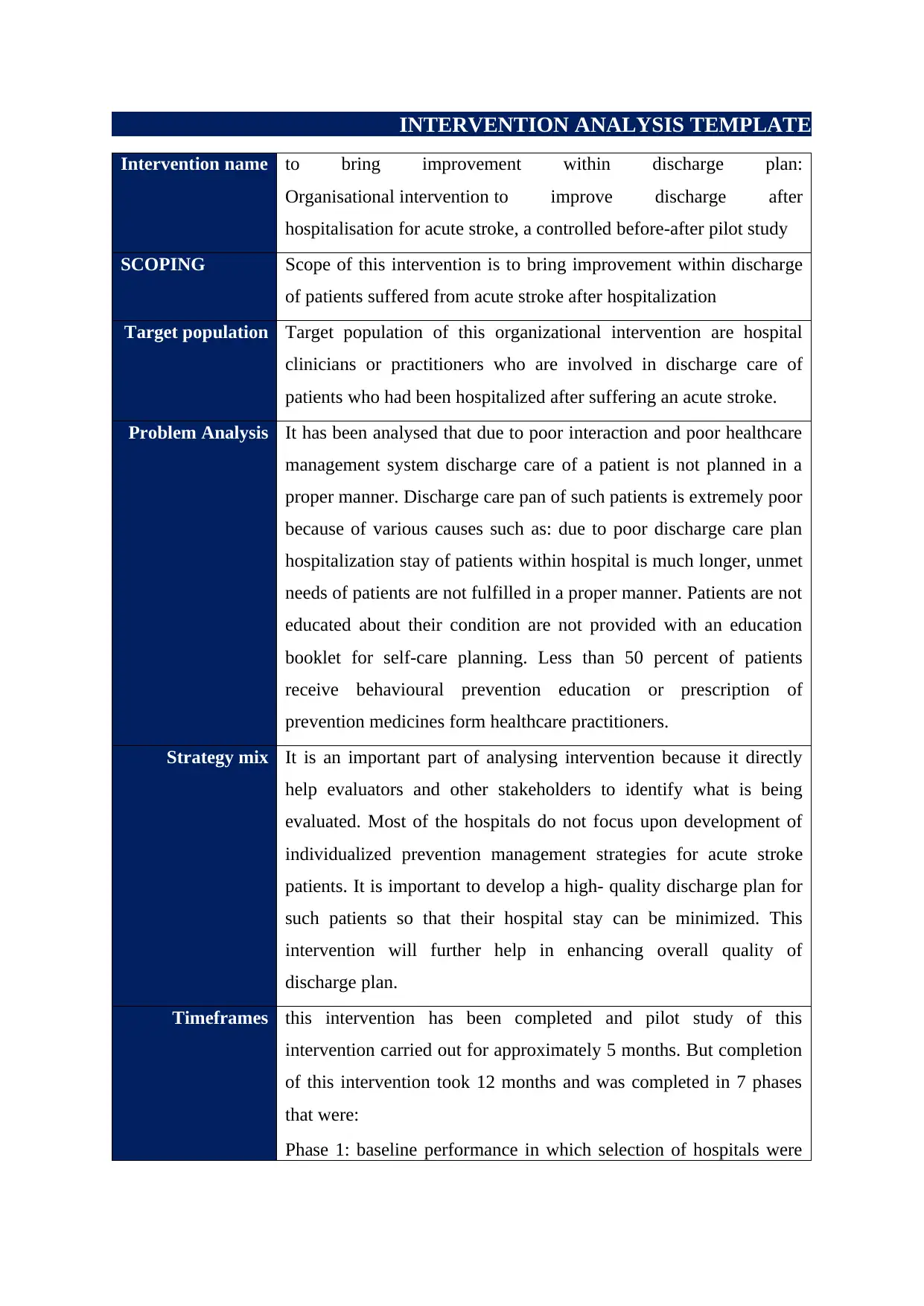
INTERVENTION ANALYSIS TEMPLATE
Intervention name to bring improvement within discharge plan:
Organisational intervention to improve discharge after
hospitalisation for acute stroke, a controlled before-after pilot study
SCOPING Scope of this intervention is to bring improvement within discharge
of patients suffered from acute stroke after hospitalization
Target population Target population of this organizational intervention are hospital
clinicians or practitioners who are involved in discharge care of
patients who had been hospitalized after suffering an acute stroke.
Problem Analysis It has been analysed that due to poor interaction and poor healthcare
management system discharge care of a patient is not planned in a
proper manner. Discharge care pan of such patients is extremely poor
because of various causes such as: due to poor discharge care plan
hospitalization stay of patients within hospital is much longer, unmet
needs of patients are not fulfilled in a proper manner. Patients are not
educated about their condition are not provided with an education
booklet for self-care planning. Less than 50 percent of patients
receive behavioural prevention education or prescription of
prevention medicines form healthcare practitioners.
Strategy mix It is an important part of analysing intervention because it directly
help evaluators and other stakeholders to identify what is being
evaluated. Most of the hospitals do not focus upon development of
individualized prevention management strategies for acute stroke
patients. It is important to develop a high- quality discharge plan for
such patients so that their hospital stay can be minimized. This
intervention will further help in enhancing overall quality of
discharge plan.
Timeframes this intervention has been completed and pilot study of this
intervention carried out for approximately 5 months. But completion
of this intervention took 12 months and was completed in 7 phases
that were:
Phase 1: baseline performance in which selection of hospitals were
Intervention name to bring improvement within discharge plan:
Organisational intervention to improve discharge after
hospitalisation for acute stroke, a controlled before-after pilot study
SCOPING Scope of this intervention is to bring improvement within discharge
of patients suffered from acute stroke after hospitalization
Target population Target population of this organizational intervention are hospital
clinicians or practitioners who are involved in discharge care of
patients who had been hospitalized after suffering an acute stroke.
Problem Analysis It has been analysed that due to poor interaction and poor healthcare
management system discharge care of a patient is not planned in a
proper manner. Discharge care pan of such patients is extremely poor
because of various causes such as: due to poor discharge care plan
hospitalization stay of patients within hospital is much longer, unmet
needs of patients are not fulfilled in a proper manner. Patients are not
educated about their condition are not provided with an education
booklet for self-care planning. Less than 50 percent of patients
receive behavioural prevention education or prescription of
prevention medicines form healthcare practitioners.
Strategy mix It is an important part of analysing intervention because it directly
help evaluators and other stakeholders to identify what is being
evaluated. Most of the hospitals do not focus upon development of
individualized prevention management strategies for acute stroke
patients. It is important to develop a high- quality discharge plan for
such patients so that their hospital stay can be minimized. This
intervention will further help in enhancing overall quality of
discharge plan.
Timeframes this intervention has been completed and pilot study of this
intervention carried out for approximately 5 months. But completion
of this intervention took 12 months and was completed in 7 phases
that were:
Phase 1: baseline performance in which selection of hospitals were
Paraphrase This Document
Need a fresh take? Get an instant paraphrase of this document with our AI Paraphraser
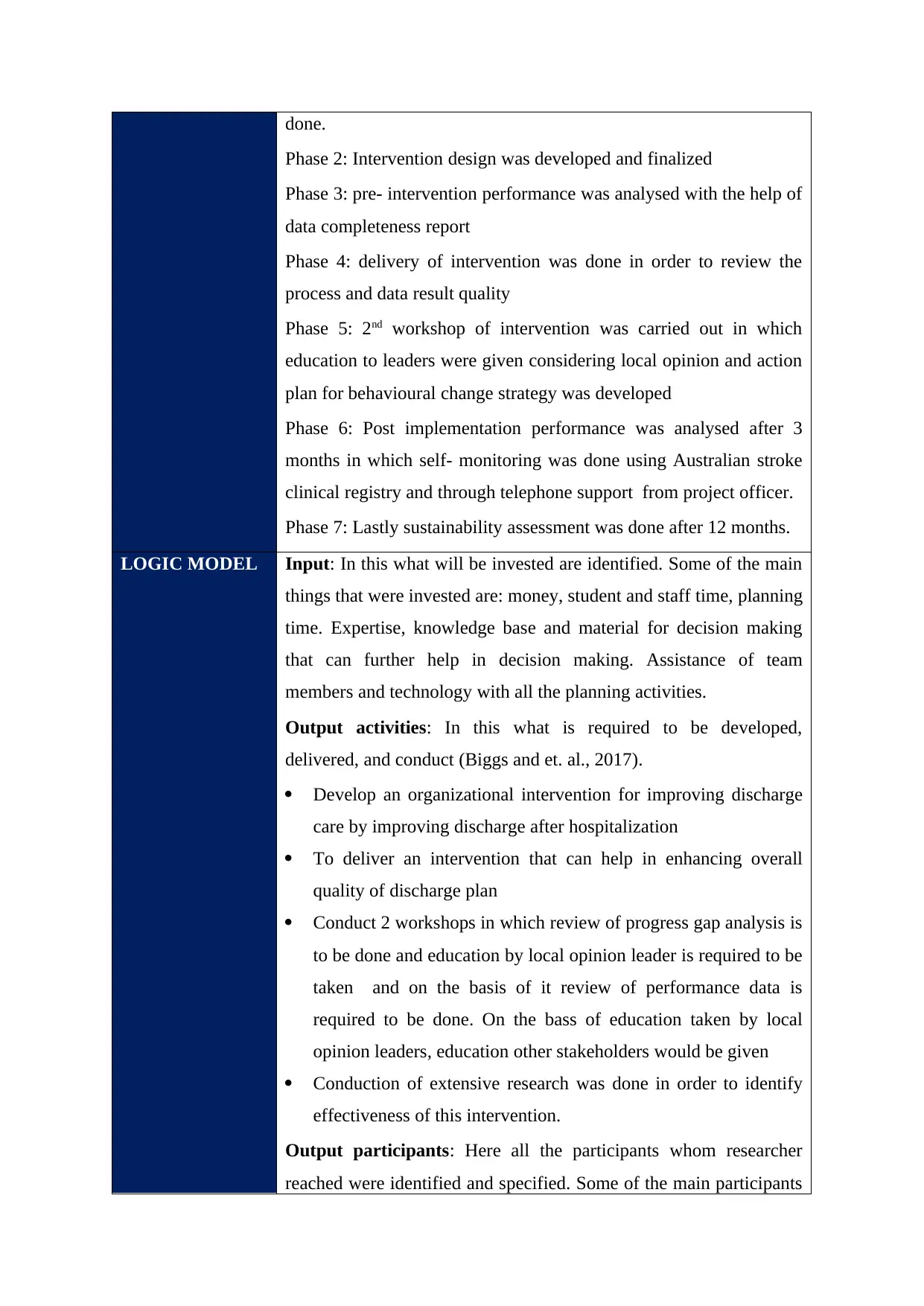
done.
Phase 2: Intervention design was developed and finalized
Phase 3: pre- intervention performance was analysed with the help of
data completeness report
Phase 4: delivery of intervention was done in order to review the
process and data result quality
Phase 5: 2nd workshop of intervention was carried out in which
education to leaders were given considering local opinion and action
plan for behavioural change strategy was developed
Phase 6: Post implementation performance was analysed after 3
months in which self- monitoring was done using Australian stroke
clinical registry and through telephone support from project officer.
Phase 7: Lastly sustainability assessment was done after 12 months.
LOGIC MODEL Input: In this what will be invested are identified. Some of the main
things that were invested are: money, student and staff time, planning
time. Expertise, knowledge base and material for decision making
that can further help in decision making. Assistance of team
members and technology with all the planning activities.
Output activities: In this what is required to be developed,
delivered, and conduct (Biggs and et. al., 2017).
Develop an organizational intervention for improving discharge
care by improving discharge after hospitalization
To deliver an intervention that can help in enhancing overall
quality of discharge plan
Conduct 2 workshops in which review of progress gap analysis is
to be done and education by local opinion leader is required to be
taken and on the basis of it review of performance data is
required to be done. On the bass of education taken by local
opinion leaders, education other stakeholders would be given
Conduction of extensive research was done in order to identify
effectiveness of this intervention.
Output participants: Here all the participants whom researcher
reached were identified and specified. Some of the main participants
Phase 2: Intervention design was developed and finalized
Phase 3: pre- intervention performance was analysed with the help of
data completeness report
Phase 4: delivery of intervention was done in order to review the
process and data result quality
Phase 5: 2nd workshop of intervention was carried out in which
education to leaders were given considering local opinion and action
plan for behavioural change strategy was developed
Phase 6: Post implementation performance was analysed after 3
months in which self- monitoring was done using Australian stroke
clinical registry and through telephone support from project officer.
Phase 7: Lastly sustainability assessment was done after 12 months.
LOGIC MODEL Input: In this what will be invested are identified. Some of the main
things that were invested are: money, student and staff time, planning
time. Expertise, knowledge base and material for decision making
that can further help in decision making. Assistance of team
members and technology with all the planning activities.
Output activities: In this what is required to be developed,
delivered, and conduct (Biggs and et. al., 2017).
Develop an organizational intervention for improving discharge
care by improving discharge after hospitalization
To deliver an intervention that can help in enhancing overall
quality of discharge plan
Conduct 2 workshops in which review of progress gap analysis is
to be done and education by local opinion leader is required to be
taken and on the basis of it review of performance data is
required to be done. On the bass of education taken by local
opinion leaders, education other stakeholders would be given
Conduction of extensive research was done in order to identify
effectiveness of this intervention.
Output participants: Here all the participants whom researcher
reached were identified and specified. Some of the main participants
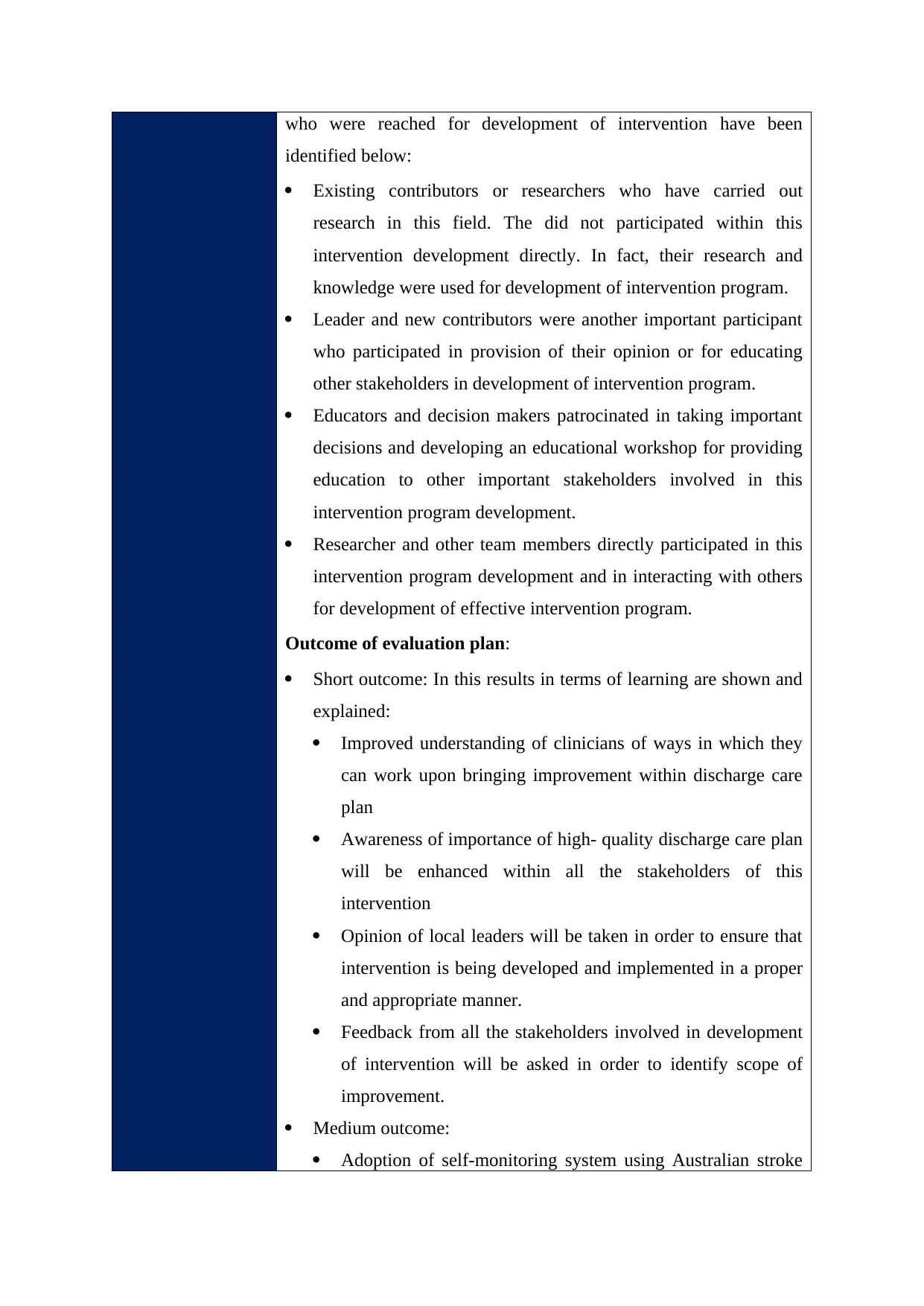
who were reached for development of intervention have been
identified below:
Existing contributors or researchers who have carried out
research in this field. The did not participated within this
intervention development directly. In fact, their research and
knowledge were used for development of intervention program.
Leader and new contributors were another important participant
who participated in provision of their opinion or for educating
other stakeholders in development of intervention program.
Educators and decision makers patrocinated in taking important
decisions and developing an educational workshop for providing
education to other important stakeholders involved in this
intervention program development.
Researcher and other team members directly participated in this
intervention program development and in interacting with others
for development of effective intervention program.
Outcome of evaluation plan:
Short outcome: In this results in terms of learning are shown and
explained:
Improved understanding of clinicians of ways in which they
can work upon bringing improvement within discharge care
plan
Awareness of importance of high- quality discharge care plan
will be enhanced within all the stakeholders of this
intervention
Opinion of local leaders will be taken in order to ensure that
intervention is being developed and implemented in a proper
and appropriate manner.
Feedback from all the stakeholders involved in development
of intervention will be asked in order to identify scope of
improvement.
Medium outcome:
Adoption of self-monitoring system using Australian stroke
identified below:
Existing contributors or researchers who have carried out
research in this field. The did not participated within this
intervention development directly. In fact, their research and
knowledge were used for development of intervention program.
Leader and new contributors were another important participant
who participated in provision of their opinion or for educating
other stakeholders in development of intervention program.
Educators and decision makers patrocinated in taking important
decisions and developing an educational workshop for providing
education to other important stakeholders involved in this
intervention program development.
Researcher and other team members directly participated in this
intervention program development and in interacting with others
for development of effective intervention program.
Outcome of evaluation plan:
Short outcome: In this results in terms of learning are shown and
explained:
Improved understanding of clinicians of ways in which they
can work upon bringing improvement within discharge care
plan
Awareness of importance of high- quality discharge care plan
will be enhanced within all the stakeholders of this
intervention
Opinion of local leaders will be taken in order to ensure that
intervention is being developed and implemented in a proper
and appropriate manner.
Feedback from all the stakeholders involved in development
of intervention will be asked in order to identify scope of
improvement.
Medium outcome:
Adoption of self-monitoring system using Australian stroke
⊘ This is a preview!⊘
Do you want full access?
Subscribe today to unlock all pages.

Trusted by 1+ million students worldwide
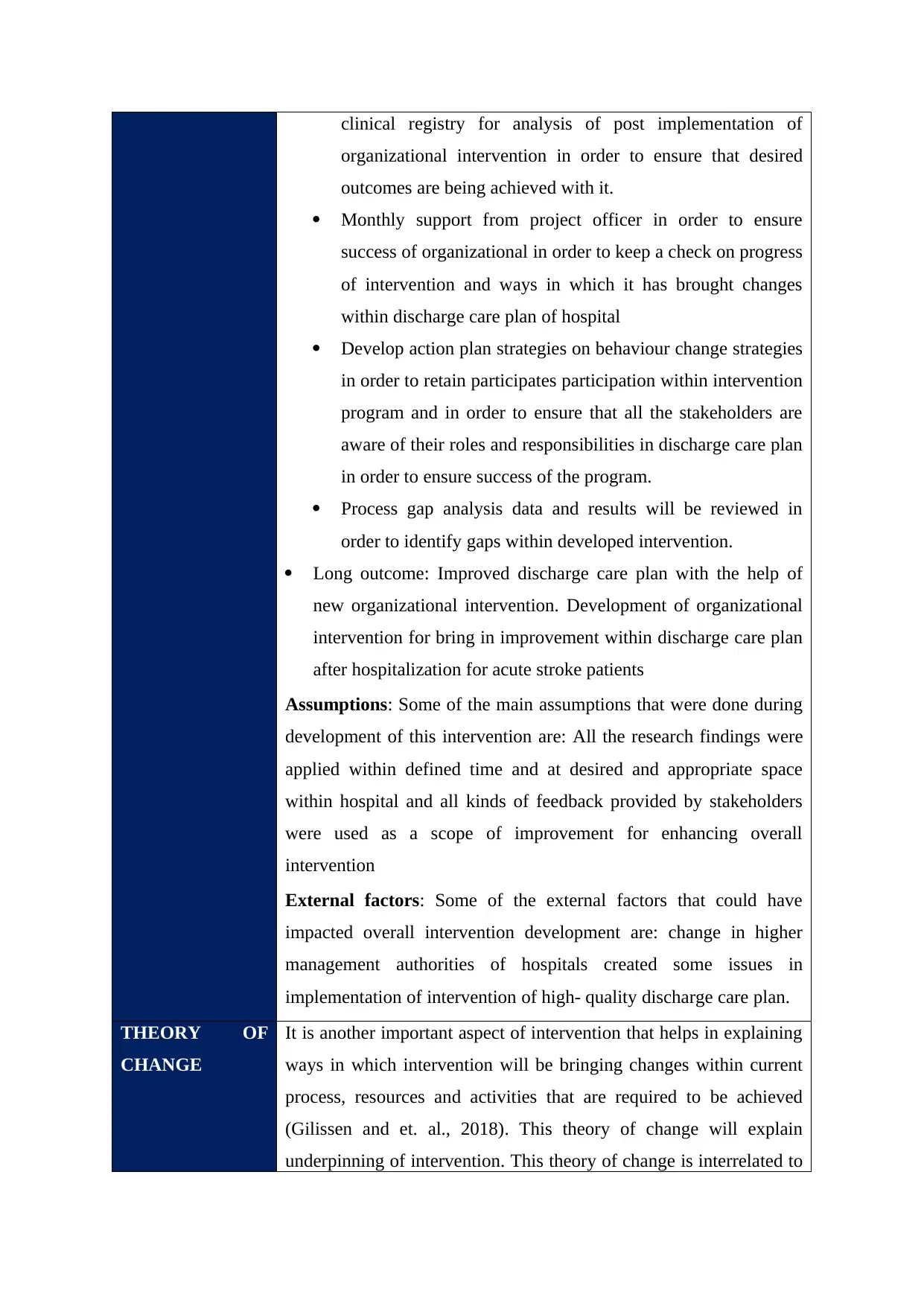
clinical registry for analysis of post implementation of
organizational intervention in order to ensure that desired
outcomes are being achieved with it.
Monthly support from project officer in order to ensure
success of organizational in order to keep a check on progress
of intervention and ways in which it has brought changes
within discharge care plan of hospital
Develop action plan strategies on behaviour change strategies
in order to retain participates participation within intervention
program and in order to ensure that all the stakeholders are
aware of their roles and responsibilities in discharge care plan
in order to ensure success of the program.
Process gap analysis data and results will be reviewed in
order to identify gaps within developed intervention.
Long outcome: Improved discharge care plan with the help of
new organizational intervention. Development of organizational
intervention for bring in improvement within discharge care plan
after hospitalization for acute stroke patients
Assumptions: Some of the main assumptions that were done during
development of this intervention are: All the research findings were
applied within defined time and at desired and appropriate space
within hospital and all kinds of feedback provided by stakeholders
were used as a scope of improvement for enhancing overall
intervention
External factors: Some of the external factors that could have
impacted overall intervention development are: change in higher
management authorities of hospitals created some issues in
implementation of intervention of high- quality discharge care plan.
THEORY OF
CHANGE
It is another important aspect of intervention that helps in explaining
ways in which intervention will be bringing changes within current
process, resources and activities that are required to be achieved
(Gilissen and et. al., 2018). This theory of change will explain
underpinning of intervention. This theory of change is interrelated to
organizational intervention in order to ensure that desired
outcomes are being achieved with it.
Monthly support from project officer in order to ensure
success of organizational in order to keep a check on progress
of intervention and ways in which it has brought changes
within discharge care plan of hospital
Develop action plan strategies on behaviour change strategies
in order to retain participates participation within intervention
program and in order to ensure that all the stakeholders are
aware of their roles and responsibilities in discharge care plan
in order to ensure success of the program.
Process gap analysis data and results will be reviewed in
order to identify gaps within developed intervention.
Long outcome: Improved discharge care plan with the help of
new organizational intervention. Development of organizational
intervention for bring in improvement within discharge care plan
after hospitalization for acute stroke patients
Assumptions: Some of the main assumptions that were done during
development of this intervention are: All the research findings were
applied within defined time and at desired and appropriate space
within hospital and all kinds of feedback provided by stakeholders
were used as a scope of improvement for enhancing overall
intervention
External factors: Some of the external factors that could have
impacted overall intervention development are: change in higher
management authorities of hospitals created some issues in
implementation of intervention of high- quality discharge care plan.
THEORY OF
CHANGE
It is another important aspect of intervention that helps in explaining
ways in which intervention will be bringing changes within current
process, resources and activities that are required to be achieved
(Gilissen and et. al., 2018). This theory of change will explain
underpinning of intervention. This theory of change is interrelated to
Paraphrase This Document
Need a fresh take? Get an instant paraphrase of this document with our AI Paraphraser
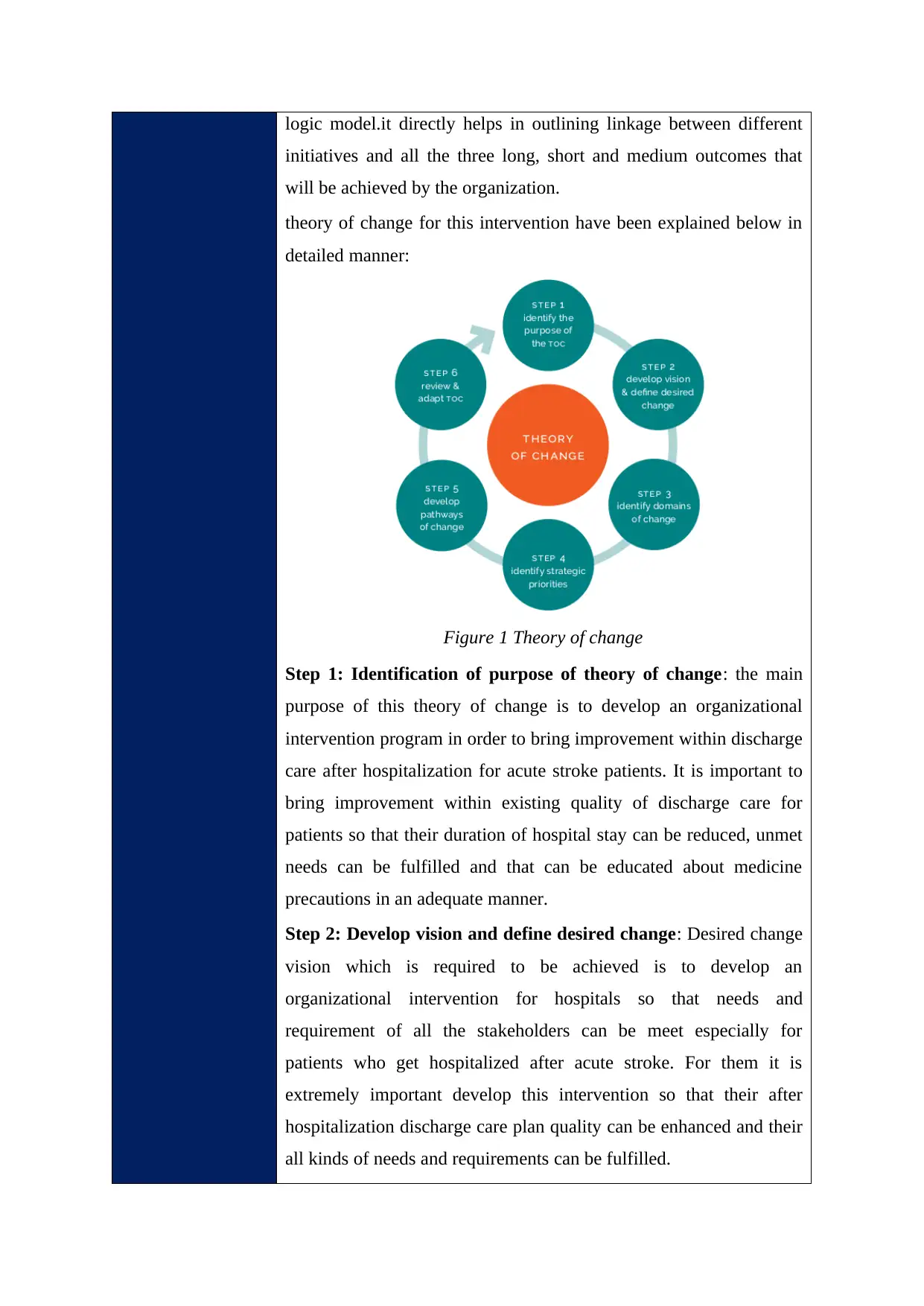
logic model.it directly helps in outlining linkage between different
initiatives and all the three long, short and medium outcomes that
will be achieved by the organization.
theory of change for this intervention have been explained below in
detailed manner:
Figure 1 Theory of change
Step 1: Identification of purpose of theory of change: the main
purpose of this theory of change is to develop an organizational
intervention program in order to bring improvement within discharge
care after hospitalization for acute stroke patients. It is important to
bring improvement within existing quality of discharge care for
patients so that their duration of hospital stay can be reduced, unmet
needs can be fulfilled and that can be educated about medicine
precautions in an adequate manner.
Step 2: Develop vision and define desired change: Desired change
vision which is required to be achieved is to develop an
organizational intervention for hospitals so that needs and
requirement of all the stakeholders can be meet especially for
patients who get hospitalized after acute stroke. For them it is
extremely important develop this intervention so that their after
hospitalization discharge care plan quality can be enhanced and their
all kinds of needs and requirements can be fulfilled.
initiatives and all the three long, short and medium outcomes that
will be achieved by the organization.
theory of change for this intervention have been explained below in
detailed manner:
Figure 1 Theory of change
Step 1: Identification of purpose of theory of change: the main
purpose of this theory of change is to develop an organizational
intervention program in order to bring improvement within discharge
care after hospitalization for acute stroke patients. It is important to
bring improvement within existing quality of discharge care for
patients so that their duration of hospital stay can be reduced, unmet
needs can be fulfilled and that can be educated about medicine
precautions in an adequate manner.
Step 2: Develop vision and define desired change: Desired change
vision which is required to be achieved is to develop an
organizational intervention for hospitals so that needs and
requirement of all the stakeholders can be meet especially for
patients who get hospitalized after acute stroke. For them it is
extremely important develop this intervention so that their after
hospitalization discharge care plan quality can be enhanced and their
all kinds of needs and requirements can be fulfilled.
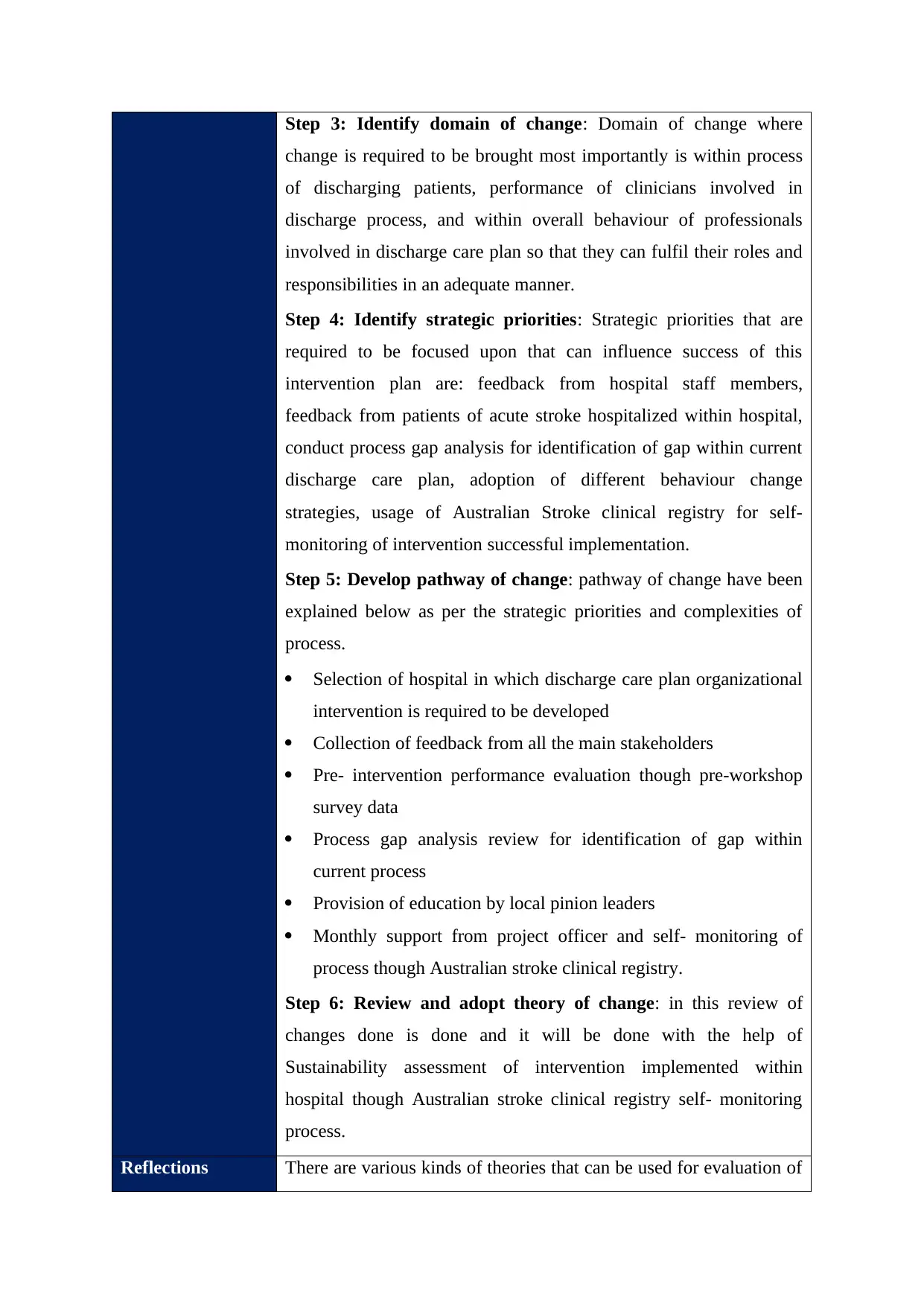
Step 3: Identify domain of change: Domain of change where
change is required to be brought most importantly is within process
of discharging patients, performance of clinicians involved in
discharge process, and within overall behaviour of professionals
involved in discharge care plan so that they can fulfil their roles and
responsibilities in an adequate manner.
Step 4: Identify strategic priorities: Strategic priorities that are
required to be focused upon that can influence success of this
intervention plan are: feedback from hospital staff members,
feedback from patients of acute stroke hospitalized within hospital,
conduct process gap analysis for identification of gap within current
discharge care plan, adoption of different behaviour change
strategies, usage of Australian Stroke clinical registry for self-
monitoring of intervention successful implementation.
Step 5: Develop pathway of change: pathway of change have been
explained below as per the strategic priorities and complexities of
process.
Selection of hospital in which discharge care plan organizational
intervention is required to be developed
Collection of feedback from all the main stakeholders
Pre- intervention performance evaluation though pre-workshop
survey data
Process gap analysis review for identification of gap within
current process
Provision of education by local pinion leaders
Monthly support from project officer and self- monitoring of
process though Australian stroke clinical registry.
Step 6: Review and adopt theory of change: in this review of
changes done is done and it will be done with the help of
Sustainability assessment of intervention implemented within
hospital though Australian stroke clinical registry self- monitoring
process.
Reflections There are various kinds of theories that can be used for evaluation of
change is required to be brought most importantly is within process
of discharging patients, performance of clinicians involved in
discharge process, and within overall behaviour of professionals
involved in discharge care plan so that they can fulfil their roles and
responsibilities in an adequate manner.
Step 4: Identify strategic priorities: Strategic priorities that are
required to be focused upon that can influence success of this
intervention plan are: feedback from hospital staff members,
feedback from patients of acute stroke hospitalized within hospital,
conduct process gap analysis for identification of gap within current
discharge care plan, adoption of different behaviour change
strategies, usage of Australian Stroke clinical registry for self-
monitoring of intervention successful implementation.
Step 5: Develop pathway of change: pathway of change have been
explained below as per the strategic priorities and complexities of
process.
Selection of hospital in which discharge care plan organizational
intervention is required to be developed
Collection of feedback from all the main stakeholders
Pre- intervention performance evaluation though pre-workshop
survey data
Process gap analysis review for identification of gap within
current process
Provision of education by local pinion leaders
Monthly support from project officer and self- monitoring of
process though Australian stroke clinical registry.
Step 6: Review and adopt theory of change: in this review of
changes done is done and it will be done with the help of
Sustainability assessment of intervention implemented within
hospital though Australian stroke clinical registry self- monitoring
process.
Reflections There are various kinds of theories that can be used for evaluation of
⊘ This is a preview!⊘
Do you want full access?
Subscribe today to unlock all pages.

Trusted by 1+ million students worldwide
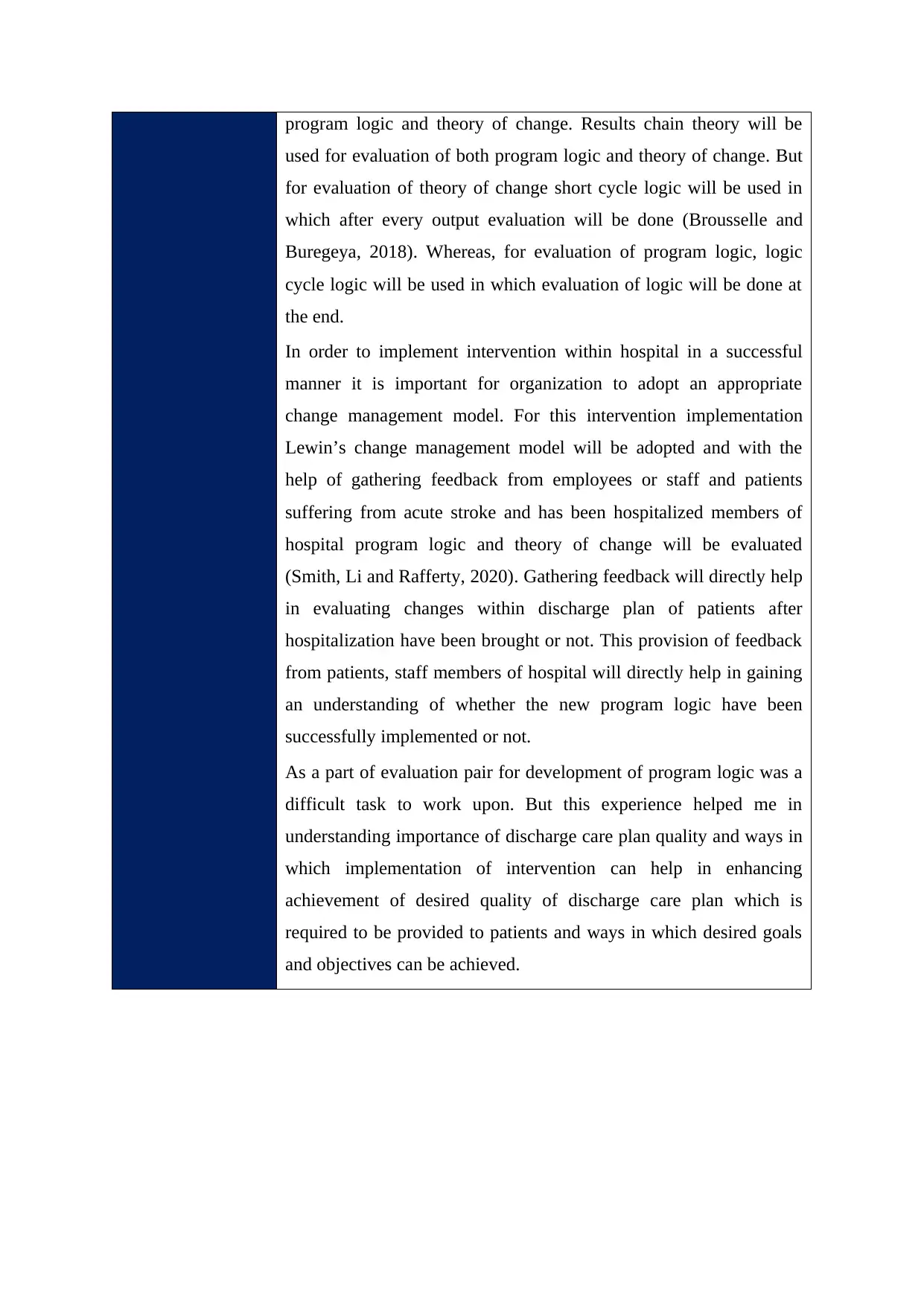
program logic and theory of change. Results chain theory will be
used for evaluation of both program logic and theory of change. But
for evaluation of theory of change short cycle logic will be used in
which after every output evaluation will be done (Brousselle and
Buregeya, 2018). Whereas, for evaluation of program logic, logic
cycle logic will be used in which evaluation of logic will be done at
the end.
In order to implement intervention within hospital in a successful
manner it is important for organization to adopt an appropriate
change management model. For this intervention implementation
Lewin’s change management model will be adopted and with the
help of gathering feedback from employees or staff and patients
suffering from acute stroke and has been hospitalized members of
hospital program logic and theory of change will be evaluated
(Smith, Li and Rafferty, 2020). Gathering feedback will directly help
in evaluating changes within discharge plan of patients after
hospitalization have been brought or not. This provision of feedback
from patients, staff members of hospital will directly help in gaining
an understanding of whether the new program logic have been
successfully implemented or not.
As a part of evaluation pair for development of program logic was a
difficult task to work upon. But this experience helped me in
understanding importance of discharge care plan quality and ways in
which implementation of intervention can help in enhancing
achievement of desired quality of discharge care plan which is
required to be provided to patients and ways in which desired goals
and objectives can be achieved.
used for evaluation of both program logic and theory of change. But
for evaluation of theory of change short cycle logic will be used in
which after every output evaluation will be done (Brousselle and
Buregeya, 2018). Whereas, for evaluation of program logic, logic
cycle logic will be used in which evaluation of logic will be done at
the end.
In order to implement intervention within hospital in a successful
manner it is important for organization to adopt an appropriate
change management model. For this intervention implementation
Lewin’s change management model will be adopted and with the
help of gathering feedback from employees or staff and patients
suffering from acute stroke and has been hospitalized members of
hospital program logic and theory of change will be evaluated
(Smith, Li and Rafferty, 2020). Gathering feedback will directly help
in evaluating changes within discharge plan of patients after
hospitalization have been brought or not. This provision of feedback
from patients, staff members of hospital will directly help in gaining
an understanding of whether the new program logic have been
successfully implemented or not.
As a part of evaluation pair for development of program logic was a
difficult task to work upon. But this experience helped me in
understanding importance of discharge care plan quality and ways in
which implementation of intervention can help in enhancing
achievement of desired quality of discharge care plan which is
required to be provided to patients and ways in which desired goals
and objectives can be achieved.
Paraphrase This Document
Need a fresh take? Get an instant paraphrase of this document with our AI Paraphraser

Logic model
Money
student and
staff time,
Planning
time
Expertise
Knowledge
base and
material
Assistance of
team
members and
technology
Develop an
organizational
intervention
Conduct 2
workshops
Researcher and
other team
members
deliver an
intervention
Leader and
new
contributors
Educators and
decision
makers
Existing
contributors
Improved
understanding of
clinicians
Inputs Outputs
Activities Participation
Outcomes
Short Medium Long
education by
local opinion
leader
Conduction of
extensive
research
Develop action plan
strategies on
behaviour change
strategies
Feedback from
all the
stakeholders
Opinion of local
leaders
Awareness of
importance of
discharge care
plan enhanced
Review of process
gap analysis
Assumptions
All the research findings were applied within defined time and at
desired and appropriate space within hospital and all kinds of
feedback provided by stakeholders were used as a scope of
improvement for enhancing overall intervention
External Factors
change in higher management authorities of hospitals created some
issues in implementation of intervention of high- quality discharge care
plan
Monthly support from
project officer in order
to ensure success of
organizational
Adoption of self-
monitoring system
using Australian
stroke clinical
registry
Improved
discharge care
plan with the
help of new
organizational
intervention
Money
student and
staff time,
Planning
time
Expertise
Knowledge
base and
material
Assistance of
team
members and
technology
Develop an
organizational
intervention
Conduct 2
workshops
Researcher and
other team
members
deliver an
intervention
Leader and
new
contributors
Educators and
decision
makers
Existing
contributors
Improved
understanding of
clinicians
Inputs Outputs
Activities Participation
Outcomes
Short Medium Long
education by
local opinion
leader
Conduction of
extensive
research
Develop action plan
strategies on
behaviour change
strategies
Feedback from
all the
stakeholders
Opinion of local
leaders
Awareness of
importance of
discharge care
plan enhanced
Review of process
gap analysis
Assumptions
All the research findings were applied within defined time and at
desired and appropriate space within hospital and all kinds of
feedback provided by stakeholders were used as a scope of
improvement for enhancing overall intervention
External Factors
change in higher management authorities of hospitals created some
issues in implementation of intervention of high- quality discharge care
plan
Monthly support from
project officer in order
to ensure success of
organizational
Adoption of self-
monitoring system
using Australian
stroke clinical
registry
Improved
discharge care
plan with the
help of new
organizational
intervention
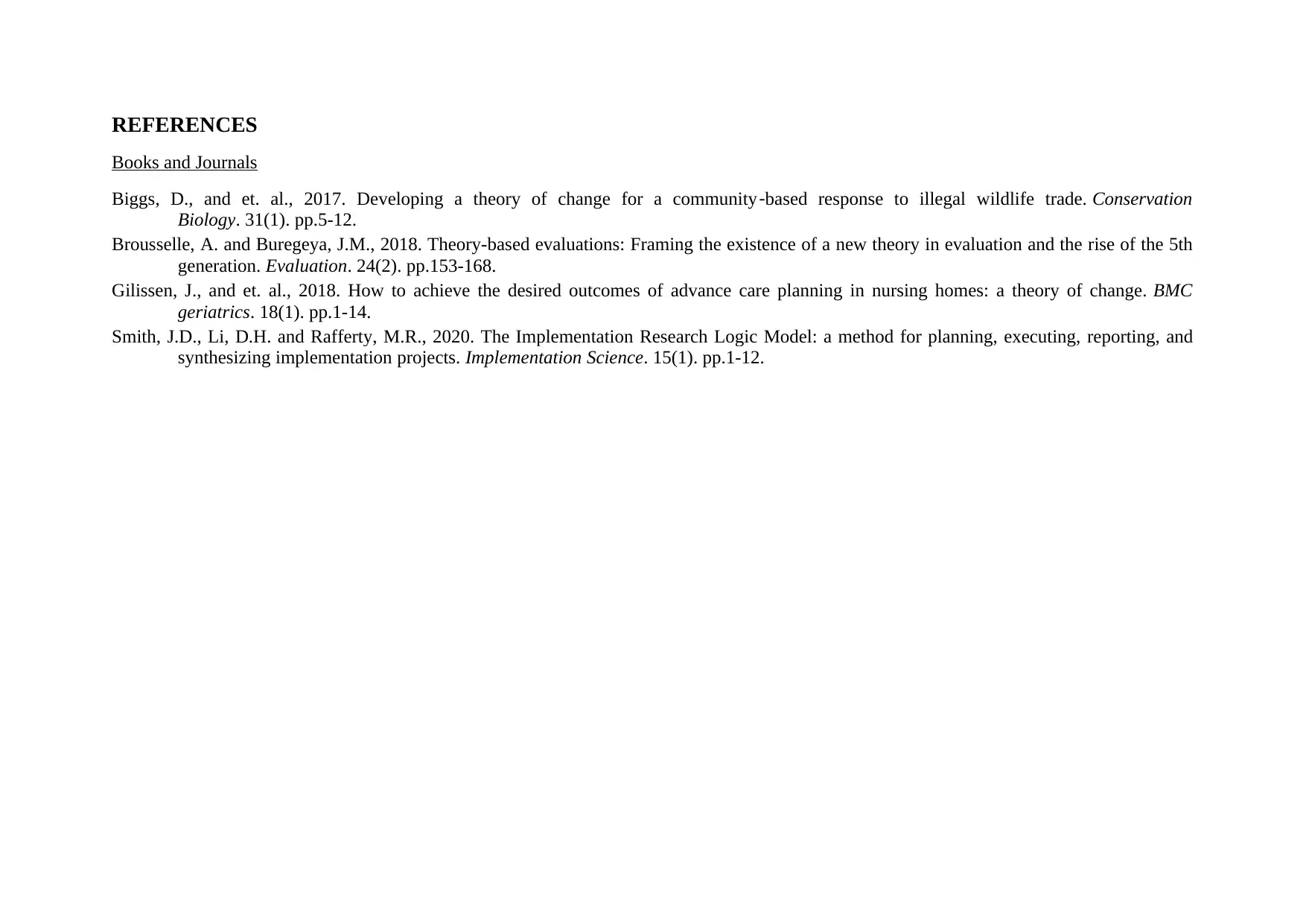
REFERENCES
Books and Journals
Biggs, D., and et. al., 2017. Developing a theory of change for a community‐based response to illegal wildlife trade. Conservation
Biology. 31(1). pp.5-12.
Brousselle, A. and Buregeya, J.M., 2018. Theory-based evaluations: Framing the existence of a new theory in evaluation and the rise of the 5th
generation. Evaluation. 24(2). pp.153-168.
Gilissen, J., and et. al., 2018. How to achieve the desired outcomes of advance care planning in nursing homes: a theory of change. BMC
geriatrics. 18(1). pp.1-14.
Smith, J.D., Li, D.H. and Rafferty, M.R., 2020. The Implementation Research Logic Model: a method for planning, executing, reporting, and
synthesizing implementation projects. Implementation Science. 15(1). pp.1-12.
Books and Journals
Biggs, D., and et. al., 2017. Developing a theory of change for a community‐based response to illegal wildlife trade. Conservation
Biology. 31(1). pp.5-12.
Brousselle, A. and Buregeya, J.M., 2018. Theory-based evaluations: Framing the existence of a new theory in evaluation and the rise of the 5th
generation. Evaluation. 24(2). pp.153-168.
Gilissen, J., and et. al., 2018. How to achieve the desired outcomes of advance care planning in nursing homes: a theory of change. BMC
geriatrics. 18(1). pp.1-14.
Smith, J.D., Li, D.H. and Rafferty, M.R., 2020. The Implementation Research Logic Model: a method for planning, executing, reporting, and
synthesizing implementation projects. Implementation Science. 15(1). pp.1-12.
⊘ This is a preview!⊘
Do you want full access?
Subscribe today to unlock all pages.

Trusted by 1+ million students worldwide
1 out of 9
Related Documents
Your All-in-One AI-Powered Toolkit for Academic Success.
+13062052269
info@desklib.com
Available 24*7 on WhatsApp / Email
![[object Object]](/_next/static/media/star-bottom.7253800d.svg)
Unlock your academic potential
Copyright © 2020–2025 A2Z Services. All Rights Reserved. Developed and managed by ZUCOL.





